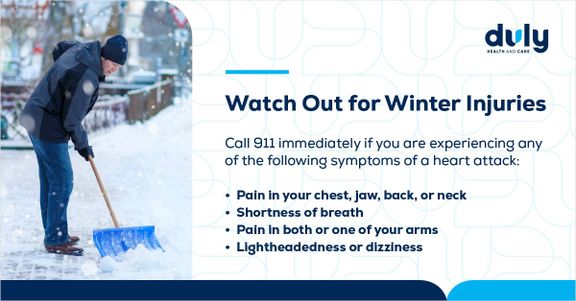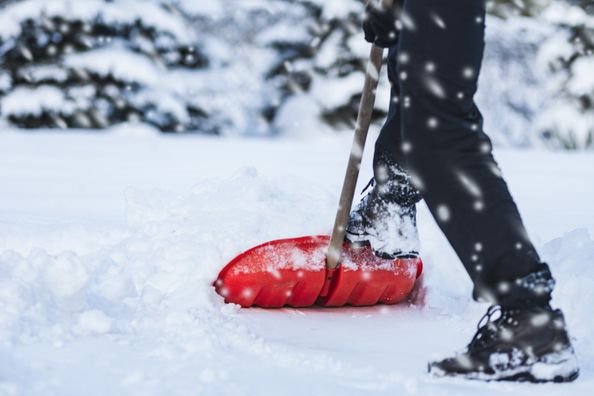A nice dusting of snow can turn your neighborhood into a winter wonderland. But it can also make it the place of unintended injuries.
From ice to snow to the colder weather, winter can bring injuries you may not think of until you’re recovering on your couch after the fact. While you may know how to treat an injury, there are actually steps you can take to prevent them as well.
This winter, focus on safety to prevent injuries by paying attention to these 4 different parts of your body.
1. Save Your Back While Shoveling
If you live in areas that receive a lot of snow, shoveling snow might be a necessity of life. When you do it year after year, it can become pretty routine. While shoveling snow may seem like just another thing many of us do each winter, it’s a winter activity that can also lead to serious injury.
Unfortunately, just because shoveling snow can lead to a range of injuries, doesn’t mean you can just stop doing it. What it does mean is it might be time to think about ways you can accomplish this task in a safer way.
Follow these steps to shovel snow — and protect your health — this winter:
- Stretch first: In the same way that you stretch before exercising, stretching before shoveling snow can help you avoid straining or spraining your muscles.
- Shovel often and early: While it can be annoying to get up multiple times during snowfall to shovel, doing so means there will be less build-up and limit the amount of snow you’re trying to lift at one time.
- Lift with your legs: Don’t lift with your back. Put less snow in your shovel, and lift with your legs to prevent back strain.
While these steps are a great way to protect you from future injuries, they aren’t helpful if you have an existing injury or health condition that makes shoveling unsafe. If you are physically unable to shovel snow, these steps may not be helpful for you — but you still have options to get that snow cleared. Don’t be afraid to ask a neighbor or family member to help you out — and do not attempt to shovel snow if you have severe back issues.
If you pull a muscle while shoveling, don’t wait until it gets worse to get help. Find an Immediate Care location near you today.
2. Keep Safety in Your Heart All Winter
In addition to protecting your muscles while shoveling, it’s also important to protect your heart.
Shoveling and other winter activities or sports can be very taxing on your body. This kind of intense work can cause a heart attack — especially if you have high cholesterol, high blood pressure, heart disease, or have already had a heart attack or stroke before.

3. Be Good to Your Bones with Home Safety
Another common place where winter injuries occur is simply walking across icy surfaces. If you trip and fall, you might break or fracture a bone — and this risk goes up the older you are. In fact, more than 36 million falls are reported each year among older adults, and there are many more people who fall but never report it.
Whether you’re worried about a fall for yourself or for an aging loved one, you can make small safety adjustments around the home and to your everyday routine to reduce the risk of a winter injury.
To prevent trips, slips, and falls, you can:
- Put down rock salt before snowfall to prevent ice.
- Be mindful of where you’re parking your car and icy patches in parking lots.
- Watch out for cords and strands of lights that might become a tripping hazard.
- Wear good shoes with treads that can grip slippery surfaces.
- Give yourself extra time to get places to allow you to walk a little slower.
- Avoid walking in dark areas where it is difficult to see slick spots or black ice.
4. Monitor Your Muscle Use
In addition to breaking or fracturing a bone while falling, you may also pull a muscle. Muscle strains are a year-round injury that can occur while shoveling snow, raking leaves, or planting flowers — it doesn’t matter what season it is. They can be a result of overusing that muscle (like while shoveling), or even just moving it in a weird way (like during a trip or stumble).
You may think the first thing to do for a muscle strain is heat, but ice is actually going to bring you more relief and healing. If you’ve pulled a muscle, apply an ice pack wrapped in a protective cloth to the injured area. You can do this for 20 minutes 2 to 3 times a day.
Stay Safe During the Winter Months
Winter can be a time of beauty spent with friends and family, but it can also easily become a season of injury and recovery. Each season comes with its own perks, but it also comes with different hazards to be on the lookout for.
This winter, keep you and your loved ones happy and healthy by being more aware — and more prepared. And if you do experience an injury, schedule an appointment with your Duly health and care provider.
Health Topics:







